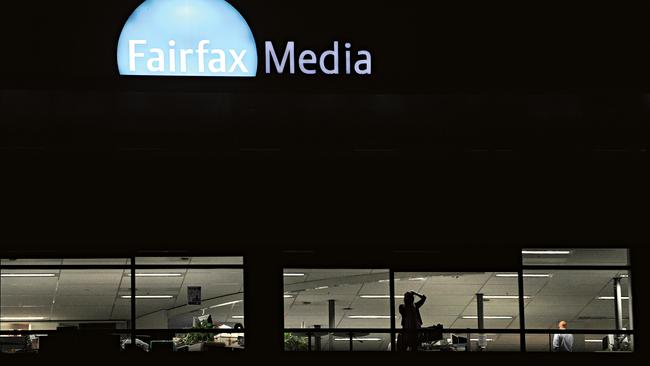Inside story: how a newspaper empire has fallen
From rural outposts to urban citadels, Fairfax has felt the chill wind of change. Journalist Ben Hills charts his former employer’s downfall.

ON November 7, 2012, the last edition of the Cobar Age rolled off the presses in Dubbo and was trucked the 300km to its dwindling band of loyal readers — just 460 of them.
“Sun sets on an age” was its last headline, superimposed over a photograph of the sun setting behind one of Cobar’s mineheads. Under various mastheads and owners the paper had a genealogy going back to 1887, a few years after the chance discovery of a great lode of copper ore led to the town’s foundation. Reid Jermyn, an “iron ringer” (the local name for someone born and bred in Cobar) and the paper’s last editor, wrote for that final edition: “Without us many of our community’s defining moments would never have been told …”
Cobar, in the far west of NSW, sits in a lunar landscape of mining mullock on the edge of the outback. The Age was the smallest and remotest of all the Fairfax titles, so distant that when the company acquired it in a merger with the Rural Press empire in 2006, its new owners didn’t even bother to visit. Yet for 125 years, under various names and proprietors, it had been the voice of this isolated community, the custodian of its history, the bulletin board of its daily life, the place where Cobar’s miners and managers, farmers and tradespeople, truckers and teachers could exchange views and read the news of their community. Once a week its pages chronicled debates at the local council, the feats of local sporting teams, goings-on in the courts — the usual fare of country life.
Reid Jermyn was the entire staff. Over the years, as costs were cut, the paper had shrunk until there was just him left to do the reporting and the editing, to take the photographs, monitor the phone and do the accounts — even to take the advertisements. Jermyn had sensed for some time that the writing was on the wall for his little paper. “It’s easy to put two and two together when you are at the coalface … You couldn’t cut costs any more, you couldn’t have a more skeleton staff than just me.”
In October 2012, after weeks of rumours, Allan Browne, the then chief executive of Fairfax Regional Media, confirmed the Cobar Age was to close — along with another struggling newspaper which had served its country community for more than 100 years, the Warren Advocate. Later it was confirmed that the “rationalisation” would also result in the closure of another weekly, the Coffs Coast Independent at the NSW North Coast holiday town of Coffs Harbour, and that The Armidale Express, established in 1856 and one of the oldest newspapers in NSW, would be cut from three editions a week to two.
The uncomfortable truth is that the Cobar Age and the other historic little papers snuffed out at a stroke of the pen by Fairfax were not killed by the internet; they were killed by competition. Under the Cobar Age’s faraway owners — whose directors could probably not find it on the map — the paper had become increasingly remote from its readers. In 1986, when John Armati’s Macquarie Publications still owned the Cobar Age, a rival publication was started 100m down the street, a “community paper” called The Cobar Weekly. I called on its managing editor, Sharon Harland, to ask why it had succeeded against a company with a million times her resources. “People wanted something more local,” she told me. “The Age was printed in Dubbo, it was focused on Dubbo; it was only four or eight pages, whereas we can do 40. We couldn’t give stories the same length and depth, but we provided a lot more variety.” There were other factors. The Weekly is owned by an elected committee of worthies and is registered as a non-profit organisation. It is printed on A4 paper on an industrial photocopier by a printer who works one day a week and its advertisements cost a fraction of what the Age would charge. Hardly surprisingly, it outsold the Age almost three to one, and it now has a monopoly in a town of 5000.
But is it the kind of paper that best serves its community? The Weekly covers road accidents but never carries pictures of them because that would be too distressing. It reports on court cases but never uses the names of those charged for fear of giving offence. “We don’t go out there and stir stuff up,” says Harland. “The Age was all drama, doom and disaster. We don’t have to have that sort of headline. We’re here to serve the community.”
Cobar. Warren. Coffs Harbour. Armidale. As 2013 drew to a close, the bean counters were running a ruler over all of Fairfax’s “businesses”. BRW magazine had been the latest to face the axe. In November, after more than 30 years as Australia’s premier business magazine, it published its final print edition and another 45 journalists hit the street. It seemed certain that more papers would be closed, more jobs lost, more stories would go untold, more communities would be stripped of a heritage for which the internet can never substitute, by a faraway proprietor in thrall to the faceless forces of the stock market.
The chatter died away, “got to goes” were whispered into mobile phones and 60 pairs of eyes followed the business-suited figure to the lectern in the ground-floor auditorium in the five-storey glass-and-steel box down by Sydney Harbour that Fairfax Media has called home for the past five of its 173 years. Tall, with his shaven head shining in the spotlight and deep frown lines etched above his nose, Fairfax chief executive Greg Hywood was dressed, appropriately, like an undertaker at an upscale funeral. His voice, when he began to speak, was ominously leaden.
The revolution Hywood announced in mid-2012 would gut the country’s oldest and most prestigious newspapers — The Sydney Morning Herald and The Age — which for nearly 200 years had provided millions of Australians with their daily news, commentary and commerce. It would change forever not just the way in which news is disseminated and paid for but its very nature. One in five of its 10,000 workers would go. Out the door went hundreds of my former colleagues in the greatest diaspora of journalistic talent this country has ever seen. Fairfax would shutter its vast, obsolete printing plants and become a digital-first news provider, and the Herald and The Age, which for two centuries had prided themselves on being “broadsheets”, a hallmark of quality, would be shrunk to a “compact” size. Subsequently the company made much of the greater convenience of the new format, particularly for people using public transport, and even boasted that it had boosted sales. The much-vaunted increase in newsagent sales would prove to be a temporary blip. The papers’ circulations soon resumed their precipitous plunge.
The changes would spawn a whole thesaurus of excruciating neologisms, causing great hilarity among the old hands. Reporters going to cover stories — crimes, courts, press conferences, the daily grist of the newsprint mill — would be called “first responders”. A whole new echelon of “platform-agnostic news directors” would decide whether to Tweet breaking news, link to video content, or protect a scoop by saving it for the next morning’s print edition. But the message was clear. Print is dead. Digital is the future. Get with it or get out. There was nothing about the Cobar Age, of course, in Hywood’s announcement; that wouldn’t come until a few months later.
Hywood saved the most important news until towards the end of his speech. As from the first quarter of 2013 (the deadline later blew out to mid-year), Fairfax would start charging for access to its online sites. All that stuff — news, comment, interviews, photos, video, wire-service output, sports — which more than a million people a week had been accessing for nothing would now have to be paid for.
As Hywood finished addressing his staff, the room was silent. Fortunately, journalism provides the clichés to match the mood. “Everyone was shocked,” says Matthew Moore, who for 28 years had been one of the Herald’s stalwarts. “There was just stunned disbelief.” For the next month little else would be discussed around the water coolers and coffee machines than who was going, who was staying, and what sort of a future there was for the papers. Hywood’s announcement would have a profound impact on thousands of Fairfax’s workers — as well, of course, as millions of readers of its journalism.
By late 2013, the impact of the staff cuts on the quality of the Fairfax papers could no longer be concealed. They were noticeably smaller and skinnier and stuffed with house ads — advertising promoting Fairfax’s business interests filling the embarrassing holes where paid display advertising was absent. Most classified advertising was long gone. Only in real estate was Fairfax hanging on, with Domain the leading brand in Sydney and Melbourne, although it lagged behind REA Group [majority-owned by News Corp Australia, parent company of The Australian] nationally. The weekend papers, in particular, were less than half the size of a decade earlier. They carried fewer stories and those stories were shorter, reflecting the dwindling attention span of the internet generation. The Herald and The Age were no longer one-stop-shop papers of record. More of the copy was sourced from wire services such as AAP, and while there is nothing wrong with this it reflects a sad loss of diversity.
There were three other obvious reasons why people could be forgiven for losing their hard-won trust in the Fairfax papers: the swarm of errors of fact, spelling and grammar that make it into print; the ever-earlier deadlines, which means the papers are out of date before they even roll off the presses; and the ever-increasing emphasis on the sort of stories that attract the most visitors online — sport, crime, celebrity and gossip. Sometime in the past few years, as Fairfax embarked on the perilous transition from print to the internet, its editors began to lose their sense of the public interest and embraced instead what traffic on its websites told them was interesting to the public.
Errors that once would have been sacking offences have become commonplace, particularly in the hands of poorly paid sub-editors in New Zealand with no knowledge of Australia. Paul McGeough, Fairfax’s peerless chief correspondent and a former editor of the Herald, must have cringed when he read this under his byline: “It’s no surprise Fairfax hears little by way of sympathy for the 39 Australians (NB SUBS: as at Feb 25. Please check if more have been killed since. Thks.) who have died there — too many Afghans have died with them.” The cheer squad for online news, where stories are often posted with next to no oversight at all, has a slogan — “Never wrong for long” — but unfortunately that doesn’t apply to the printed paper.
Page two of the Herald is a daily embarrassment, correcting up to three or four clangers from the previous day’s paper — things as basic as getting the name of South Korea’s first female president wrong, and calling her a man. Although former Herald editor Peter Fray (now deputy editor, news, at The Australian) says we have no data to prove it, this failure of quality control must undermine the papers’ credibility and give their critics unnecessary ammunition. Not for nothing is London’s error-strewn Guardian of the 1970s still trying to shake off its nickname of The Grauniad.
Some mistakes can have serious consequences. In August 2013, the Murdoch papers were crowing over a “fat finger” error on The Australian Financial Review website. The paper misplaced a decimal point in a story about the government’s plans to introduce a 0.05 to 0.1 per cent levy on bank deposits — but that keystroke was enough to temporarily wipe around $9 billion off the value of Australian banks, as panicky investors dumped their stock.
Secondly, the decision to put an end to the late-night second editions of the papers must also have had an impact on sales. Two decades ago, a midnight edition was the norm, and an important breaking story could be dropped into the papers’ metro edition as late as 3am. Now, with an 8.30pm deadline, there is very little in the morning paper that wasn’t on the previous evening’s TV bulletins, which are still the way most Australians get their news. Margaret Thatcher’s death was the Fairfax papers’ most conspicuous no-show of 2013. But there were plenty of other stories which should have made it into the paper but didn’t.
And finally, the impact of the internet on the papers’ story choices has become ever more problematic. There are days when Fairfax’s mastheads — in print and online — are a schizophrenic contest between what readers need to know to understand the world around them and what titillating titbits have attracted the most guffaws online. It is almost a throwback to the 1970s, when two papers rolled off the presses daily at the old Broadway building — staid grey “Granny Herald” in the morning, and the downmarket tabloid The Sun in the afternoon. Except these days, to the confusion of the readers who rely on the editors for a coherent agenda, both bear the same online masthead of Fairfax Media. In the headlong chase after reader numbers, no one seemed to remember that when The Sun was shuttered in 1988 its circulation was not far short of the Herald’s, but it was losing $20 million a year. What made one paper profitable and the other not was not the number of readers; it was their comparative socio-economic status and their attractiveness to advertisers.
Fairfax, helpfully, publishes a list of its top online stories of the week every Saturday, so we have good evidence about the contrast between what attracts online and print readers. In a week in which McGeough was filing a major series from the battlefront in Afghanistan, Julia Gillard’s leadership was under threat and Kate McClymont was making sensational new allegations of corruption against Eddie Obeid, the top story on smh.com.au was Shane Watson flying home after being dropped from Australia’s Test team. The second story was an opinion piece by a New York lawyer arguing that it was time to “kill off the email signature”. Number three was the election of Pope Francis, which narrowly pipped a report on social media anxiety over Domino Pizza’s “most important announcement in 20 years”, which turned out to be some new toppings and a square base.
During the week in which both sides of politics endorsed the National Disability Insurance Scheme — the most important social reform since Medibank — it did not feature among Fairfax’s Top Five online stories. What did were: “Kris Kross rapper Kelly dead at 34” (number three), “‘Appalling taste’: Foxtel to remove bestiality billboard” (four), and “Legally dead woman turns up — after 11 years” (five). The problem many readers — and a lot of journalists — have with what they see as this “dumbing down” of Fairfax’s news coverage is that the sort of stories which are popular online, “clickbait” as they are called, are increasingly setting the agenda for the print editions of the Herald and The Age.
It is hard to believe that this is the sort of content Fairfax readers will buy — and companies will pay good money to advertise alongside — when this kind of story is done so much better by the tabloids and on TV, and is shared by millions for nothing on social media.
By the middle of 2014, Fairfax’s fortunes had made a modest recovery from their lowest ebb, due not to the success of its newspapers, which were bleeding revenue and circulation apace, but to its transformation from a news organisation to a hodgepodge of online businesses. The Fairfax of the Future is an eclectic combination of real estate spruiker, lonely hearts matchmaker, baby goods retailer, organiser of food fairs and promoter of fun runs, ocean swims and soirees showcasing business moguls. The newsrooms continue their inexorable decline with the departure of many of their marquee writers, photographers and editors. I had my lifetime during the golden age of newspapers. The people I feel sorriest for are those left to labour bravely away among the ruins.
Edited extract from Stop The Presses! How Greed, Incompetence (and the internet) wrecked Fairfax, by Ben Hills (ABC Books, $39.99)


